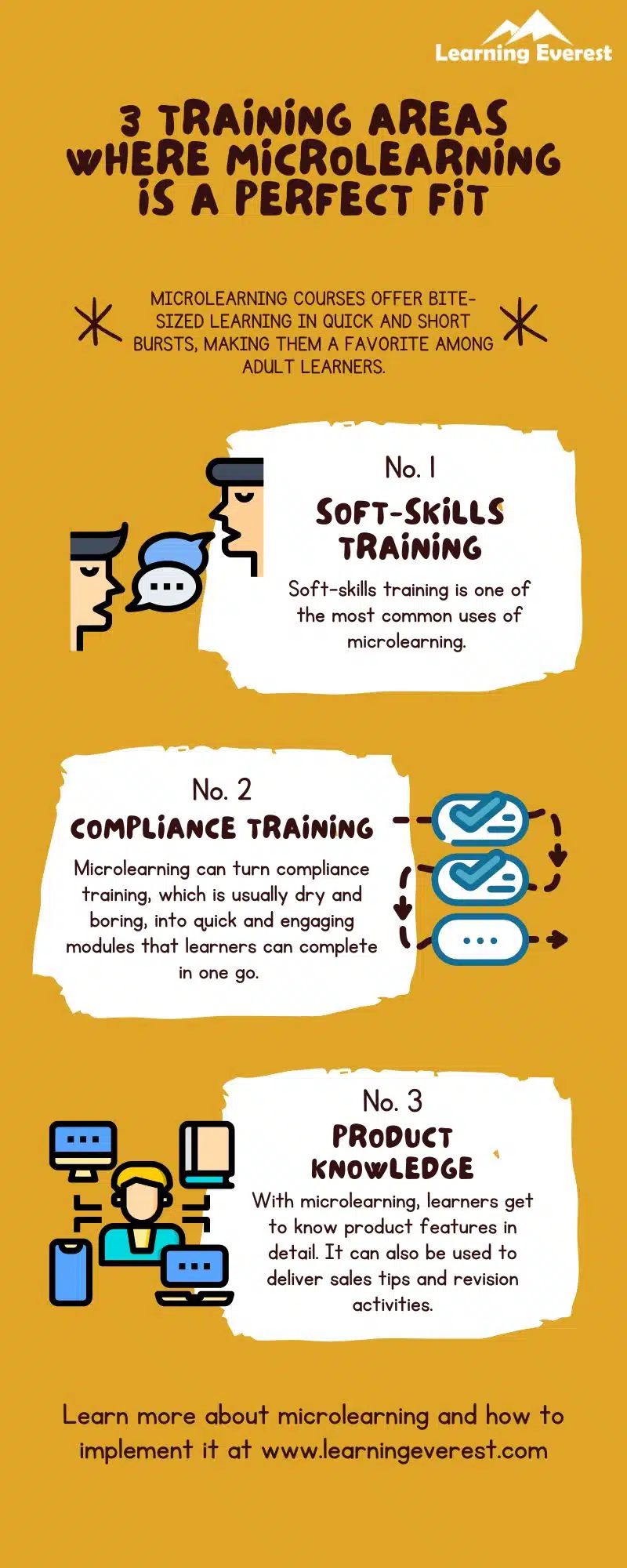What are the areas where microlearning is a perfect fit? Microlearning courses offer bite-sized learning in quick and short bursts, making them a favorite among adult learners. The approach aims to weave highly relevant targeted of learning into the natural flow of work for minimal disruption to everyday tasks. According to the Journal of Applied Psychology, microlearning is 17% more effective than other forms of learning. However, it also comes with its caveats. As the complexity of a topic and the level of mastery required increases, microlearning’s benefits diminish. Hence, it is important to use the approach for the right training needs. This article will list 3 areas where microlearning is a highly effective approach. We will also look at some microlearning strategies commonly used in training.
Table of Contents
1. Microlearning Examples – Soft-Skills Training
Soft-skills training is one of the most common uses of microlearning. Everyday abilities such as communication, planning, teamwork, etc. fall under this category. Developing these skills requires the right environment, and many are also associated with certain personality traits. Hence, the soft skills spread in any workforce tend to be very varied.
However, soft skills are vital to an organization’s smooth functioning. These personal abilities influence employee success, the overall emotional environment of the workplace, and interactions with customers and stakeholders.
Microlearning is a great tool to teach one soft skill at a time so employees can understand and master it. In this way, organizations can build and refine a wide range of soft skills in their workforce over time.
2. Microlearning Examples – Compliance Training
Microlearning can turn compliance training, which is usually dry and boring, into quick and engaging modules that learners can complete in one go.
Just like soft-skills training, the idea is to lay down regulations one at a time. This reduces the risk of employees forgetting important policies as the learning they get tackles one topic at a time.
Another benefit of microlearning is that it allows for new ways to train employees in highly regulated industries. These are industries where compliance policies influence all behavior at work and non-compliance comes with huge risks as well as repercussions. Some examples are the nuclear industry, healthcare, aviation, and finance.
In these industries, long workshops and handbooks can be replaced or supplemented with bite-sized microlearning modules that employees can always have ready access to. A learner-centric approach to compliance training, in turn, will reduce the occurrence of misconduct.
3. Microlearning Examples – Product Knowledge
Another area where microlearning excels is product knowledge. Sales and retail are fast-paced jobs that require constant interaction, making pitches, and convincing people.
Making a good sales pitch has two core requirements:
- A keen understanding of the target buyer demographic
- A keen understanding of the product you’re pitching and how it will add value to buyers’ lives
With microlearning, learners get to know each product’s features in detail. At the same time, microlearning can also be used to deliver sales tips and revision activities to learners so they can brush up on their product knowledge as and when they need it.
Microlearning modules typically have responsive designs or are designed for mobile devices specifically. Thus, learners can access them while on the job. This is another reason why product knowledge and microlearning fit well together.
Microlearning Strategies
Microlearning is a flexible approach with several benefits and can easily be used in areas other than the ones mentioned above. The only conditions are that the learning material isn’t highly complex or requires complete mastery of concepts and skills. For example, microlearning cannot replace medical residencies. However, even in these cases, microlearning makes for an excellent supplementary tool.
This section will list some common microlearning strategies to give you an idea of the forms it can take:
- Interactive e-learning modules – this kind of microlearning is developed on rapid authoring tools and presents information in the form of clickable tabs, sliders, drop-downs, etc. The learner interacts with the elements in the course to learn about the topic, but the content is light and digestible. Such courses can also have voiceovers, so learners don’t just get visual input but also audio input.
- Infographics, pamphlets, PDFs, and booklets – consumable reading materials and graphics, whether digital or physical, also count as microlearning. Such mediums offer a way to combine highly relevant information in one place and are very user-friendly. You can also add graphics and charts to these microlearning materials. Additionally, there are many templates and tools online that you can use to quickly produce such materials.
- Gamification – gamification is a technique that applies game elements to non-game environments. Microlearning can be gamified using quizzes, roleplays, branching exercises, puzzles, and more. Gamification makes learning highly engaging, enabling learners to interact with the information meaningfully so that the learning sticks.
- Videos – we have all learned something from a video at some point in our lives. Videos are an effective multi-modal source of information through which people can learn using both, visual and audio input. Explainer videos, demos, simulations, skits, animations, and lectures are some of the common ways in which microlearning utilizes this medium.
Infographics

3 Training Areas Where Microlearning is a Perfect Fit





